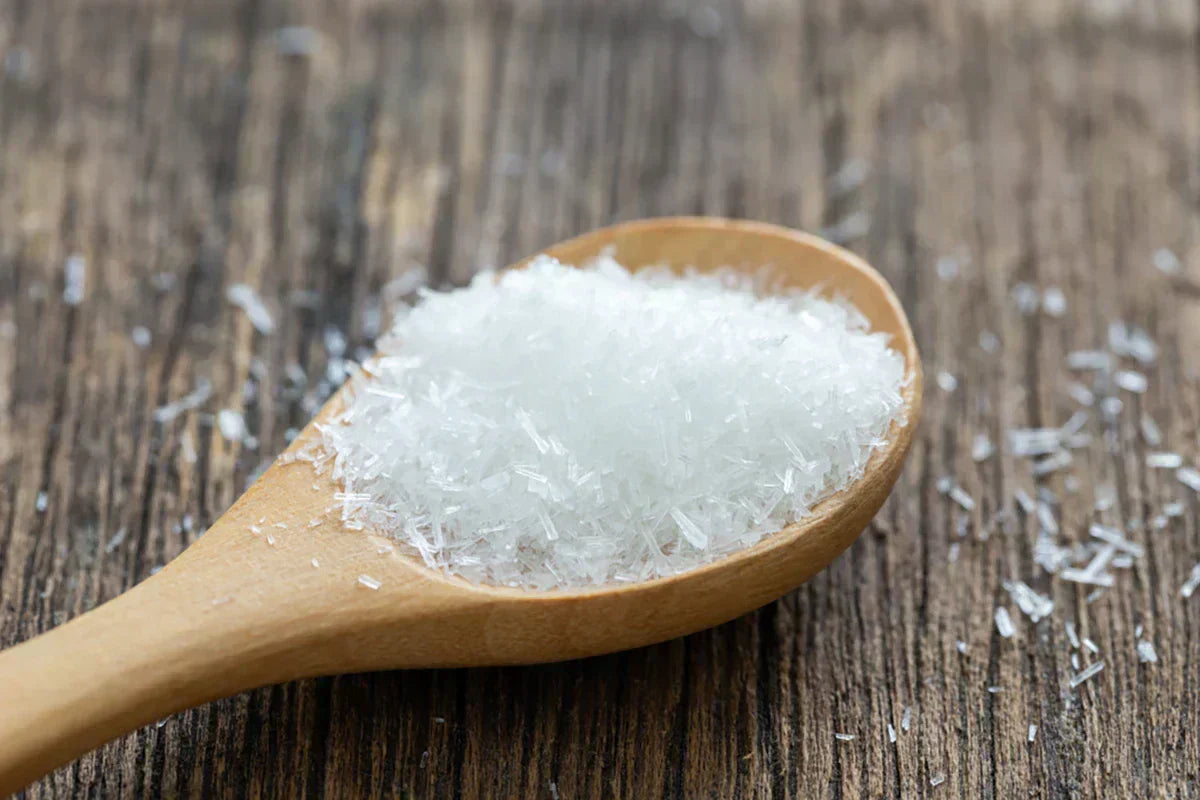
Never has an ingredient needed more of an image makeover than MSG - monosodium glutamate.
Although the health scare centred around MSG being responsible for so-called Chinese Restaurant Syndrome began almost 50 years ago, you can still see products to this day displaying “No MSG” on their labels.
We believe it’s time to rethink our relationship with MSG. Firstly, let’s understand what MSG actually is and how it came to be.
The discovery that changed flavour forever: The history of MSG
The story begins in 1908 with a simple dinner conversation. Dr Kikunae Ikeda, a Japanese biochemist, was enjoying a bowl of vegetable and tofu soup prepared by his wife when he became intrigued by its rich, savoury flavour. When he asked about the distinctive taste, she said that it was probably the kombu, a dried seaweed traditionally used in Japanese dashi broth.
In his lab, Dr Ikeda was determined to recreate and isolate the taste. Through meticulous experimentation with kombu, he extracted a crystalline compound - glutamic acid, a naturally occurring amino acid.
When he tasted these crystals, he discovered a flavour that was neither sweet, sour, salty or bitter. It was unique, and he named it 'umami', derived from the Japanese word 'umai' (delicious).
Dr Ikeda was business smart as well as science smart. Recognising the potential of his discovery, he patented the world's first umami seasoning in 1908, naming it Ajinomoto - "the essence of taste".
Dr. Ikeda filed a patent in 1908 to begin production of the world’s first umami seasoning, what we call MSG today. At The Wasabi Company, we exclusively stock MSG from Dr Ikeda's original company, which has spent over a century refining their production process. Other manufacturers often produce MSG that has a bitter aftertaste or fails to deliver the same depth of flavour.

Original patent, trademark and bottle, 1909
How MSG is made: The science of glutamic acid and fermentation
Today's Ajinomoto MSG production begins with sugarcane and relies on a sophisticated fermentation process:
- Glucose extraction: Sugarcane is processed to extract glucose, which serves as the primary food source for the microbes responsible for fermentation.
- Fermentation: The glucose is added to fermentation tanks, where specialised microbes are introduced. These microbes consume the glucose, producing glutamic acid as a byproduct.
- Neutralisation: The glutamic acid is transformed into a solution through a process called neutralisation.
- Purification: The solution is carefully de-colourised and filtered to ensure its purity.
- Crystallisation: Using an evaporator, the purified solution is crystallised, and the resulting crystals are dried to form the final product.
What's particularly impressive about this production method is its sustainability. The byproducts from Ajinomoto's MSG production aren't simply discarded - they're returned to the soil as fertiliser for future sugarcane crops.
Debunking common MSG myths and misconceptions
Despite its natural origins and widespread use in global cuisine, MSG endured a misguided smear campaign which began in the late 1960s.
The controversy began with a letter to the New England Journal of Medicine describing supposed symptoms after eating at Chinese restaurants, leading to the term "Chinese Restaurant Syndrome".
Despite studies consistently showing that MSG is safe for consumption, these fears persist. MSG can’t shake its bad boy image despite being naturally present in many foods we eat daily – from tomatoes and cheese to mushrooms and nuts. The glutamate in MSG is chemically identical to the glutamate found in these natural sources.
What is Umami? The role of MSG in flavour

MSG is concentrated umami - that deep, savoury taste that makes food satisfying and memorable.
While we can recognise four basic tastes (sweet, sour, salty, and bitter), umami is the confirmed fifth taste that completes our palate.It is responsible for the rich flavour in aged cheeses, cured meats and hearty broths. Indeed, MSG's discovery led to the formal recognition of umami as a distinct taste.
When you add MSG to a dish, you're enhancing this natural umami taste, just like adding salt – both are flavour enhancers that help other tastes shine. Just as salt brings out the best in sweet and sour flavours, it amplifies the savoury qualities of your food.
MSG vs salt
Looking to reduce your sodium intake? MSG might be your new best friend. While it contains sodium, you need far less MSG than salt to achieve a satisfying flavour. Try these approaches:
- Start with a mixture of 2/3 salt to 1/3 MSG in your salt cellar
- Gradually move to a 50/50 ratio as your palate adjusts
- Experiment with different ratios until you find your perfect balance
How to cook with MSG

With MSG, a little goes a long way – just a pinch can transform your dish from good to extraordinary. But knowing when and how to use it makes all the difference.
Where to use MSG
- Before cooking: Perfect for meats headed to the grill or vegetables bound for roasting.
- Bonus tip: MSG enhances browning when used as a surface seasoning with high heat. It’s the perfect accompaniment to use in rubs and marinades when cooking with our konro grills.
- During cooking: Add it to soups, stews, sauces and gravy as they simmer, just as you would with salt. This allows the MSG to meld with other ingredients and develop a deeper flavour profile.
- After cooking: Use it as a finishing touch just before serving when you want an immediate burst of umami flavour.
- Plant-based dishes: Adds depth and satisfaction to vegetables, beans and grains, especially where the lack of a meat or fish based stock can leave the dish a bit flavourless.
- Proteins: Enhances meat, poultry and seafood whether in a braise or sprinkled before cooking.
- Soups: Brings out the savoury notes in broths and makes them more satisfying.
- Salad dressings: Helps bring together all the elements of a good dressing.
- Savoury baking: Adds intrigue to biscuits and baked goods containing cheese, ham or sausage.
- Egg dishes: Pairs perfectly with eggs when used alongside salt.
- Pasta sauce: A pinch can elevate even store-bought tomato sauce to new heights.
- Fun applications: Try it on buttered popcorn instead of parmesan, or get creative with cocktails - it can add depth to a Bloody Mary or rim of a spicy margarita glass.
Where to avoid MSG
- Sweet dishes: Generally, MSG feels out of place in desserts (though it can be interesting in chocolate).
- Umami-rich foods: Be cautious when using MSG with ingredients already high in umami, like aged cheeses, dried shiitake mushrooms, soy sauce, miso, fish sauce or aged meats - it can overwhelm rather than enhance.
The Wasabi Company’s top MSG tips
- Don't use MSG as a direct salt replacement. While it contains sodium, you'd need too much to achieve the same saltiness, which could make your food taste unpleasant.
- Remember that MSG enhances good food - it's not a fix for poor ingredients or cooking. Think of it as a supporting actor that makes the star shine brighter.
- MSG works best with relatively bland foods where its impact can be clearly detected. In very flavourful dishes, its effect might be less noticeable.
How to bring MSG into your diet
Start by keeping a bowl of MSG next to your salt and pepper - it should be just as accessible for that quick pinch when needed. For your first experiments, try this ratio: mix 2/3 salt with 1/3 MSG. This simple blend can make your food taste amazing, while naturally reducing sodium intake. If you don’t like exact measurements, add less salt than you normally would to a soup or dish while it’s cooking and then sprinkle in some MSG and see how the taste changes. Keep adding until you are happy with the flavour.
The key to mastering MSG is experimentation. With time and practice, you'll develop an intuition for how much to use and where you enjoy it most. Soon enough, you might find yourself reaching for it as naturally as you do for salt and pepper.
The Wasabi Company’s take on MSG
I have a jar of MSG next to the hob along with the salt and pepper. I often cook plant based dishes and getting a deep, rich flavour can be challenging. MSG has become indispensable for these dishes. I usually add a small pinch to soups, tomato sauce for pasta (it’s amazing for getting rid of that overly acidic thin taste that some tomatoes can have), curries, broths, stews - to be honest, I add a pinch to just about anything.
Before MSG, I used veggie stock cubes to achieve a depth of flavour but everything ended up tasting of veggie stock cubes. The good thing about MSG is it never overpowers, it only enhances the flavours already present. And this also means that you can’t rely on it to do all the heavy lifting for you - you still have to make an effort with the various herbs and spices. But it just finishes everything off nicely.
If you don’t like exact measurements, then start by adding slightly less salt than you normally would to a soup or dish while it’s cooking and then sprinkle in some MSG and see how the taste changes. Keep adding until you are happy with the flavour.
The key to mastering MSG is experimentation. With time and practice, you will develop an intuition for how much to use and where you enjoy it most. Soon enough, like me, you might find yourself reaching for it as naturally as you do for salt and pepper. If the idea of using MSG still doesn’t sit right, then try calling it by its original name, Ajinomoto, this might just make it more appealing and remove the unjustified negative connotations that persist for MSG.
With these tips in hand, you're ready to explore the wonderful world of MSG. Whether you're grilling, roasting or whipping up a salad dressing, this versatile ingredient can help you create more flavourful dishes while potentially using less salt. And if the idea of using MSG still doesn’t sit right, then maybe calling it by its original name, Ajinomoto, might make it more appealing.

